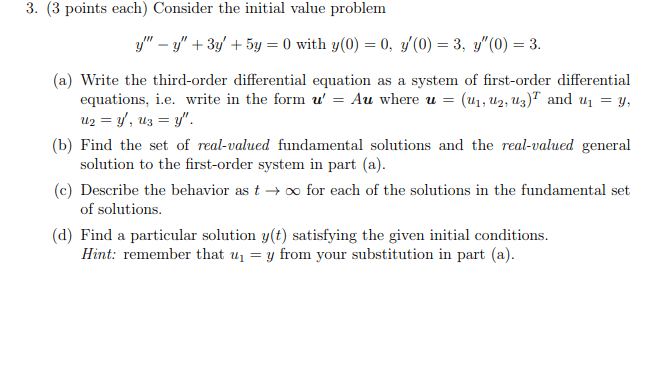MATH 33B Lecture Notes - Lecture 10: Parallelogram, Wronskian, Differentiable Function
Document Summary
An initial condition for this problem is of the form (cid:1876) =(cid:1856)(cid:2870)(cid:1876)(cid:1856)(cid:2870)=(cid:4666),(cid:1876),(cid:1876) (cid:4667) A linear second-order differential equation takes the form (existence and uniqueness) (cid:1876) (cid:4666)(cid:4667)=(,(cid:1876)(cid:4666)(cid:4667),(cid:1876) (cid:4666)(cid:4667)) for all and {(cid:1876)(cid:4666)(cid:2868)(cid:4667)=(cid:1876)(cid:2868) (cid:1876) (cid:4666)(cid:2868)(cid:4667)=(cid:1876)(cid:2869) (cid:4666)(cid:1855)(cid:2869)(cid:1876)+(cid:1855)(cid:2870)(cid:1877)(cid:4667)=(cid:4666)(cid:1855)(cid:2869)(cid:1876)+(cid:1855)(cid:2870)(cid:1877)(cid:4667) +(cid:1868)(cid:4666)(cid:4667)(cid:4666)(cid:1855)(cid:2869)(cid:1876)+(cid:1855)(cid:2870)(cid:1877)(cid:4667) +(cid:1869)(cid:4666)(cid:4667)(cid:4666)(cid:1855)(cid:2869)(cid:1876)+(cid:1855)(cid:2870)(cid:1877)(cid:4667) A solution to the initial-value problem is a twice-continuously differentiable function (cid:1876): (cid:4666) , (cid:4667) The interval (cid:4666) , (cid:4667) is called the interval of existence and it is the largest interval containing (cid:2868) on which (cid:1876) is twice continuously differentiable and verifies the equation. (cid:1876) +(cid:1868)(cid:4666)(cid:4667)(cid:1876) +(cid:1869)(cid:4666)(cid:4667)(cid:1876)=(cid:4666)(cid:4667) Here, is the independent variable (cid:1868)(cid:4666)(cid:4667),(cid:1869)(cid:4666)(cid:4667),(cid:4666)(cid:4667) are given functions (cid:1876)(cid:4666)(cid:4667) is the unknown. If the forcing term =0, this is called a homogeneous e(cid:395)uation. It"s (cid:272)alled linea(cid:396) (cid:271)e(cid:272)ause the fun(cid:272)tional (cid:4666)(cid:1876)(cid:4667)=(cid:1876) +(cid:1868)(cid:4666)(cid:4667)(cid:1876) +(cid:1869)(cid:4666)(cid:4667)(cid:1876) is linear, that is, (cid:4666)(cid:1855)(cid:2869)(cid:1876)+(cid:1855)(cid:2870)(cid:1877)(cid:4667)=(cid:1855)(cid:2869)(cid:4666)(cid:1876)(cid:4667)+(cid:1855)(cid:2870)(cid:4666)(cid:1877)(cid:4667) where (cid:1876),(cid:1877) are functions and (cid:1855)(cid:2869),(cid:1855)(cid:2870) (cid:4666) , (cid:4667) are constants. Then there exists a unique solution (cid:1876): (cid:4666) , (cid:4667) to the initial-value problem. Note: (cid:1876) exists on the same interval !





